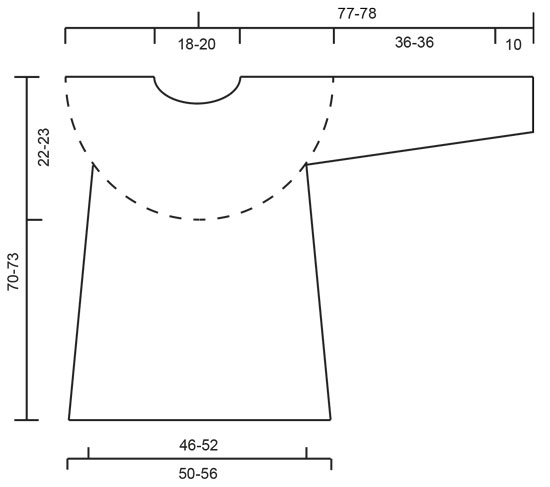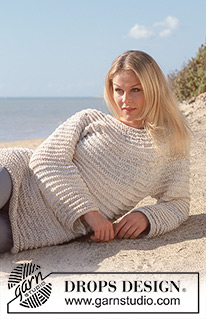Comments / Questions (13)
![]() Marianne Gindrup wrote:
Marianne Gindrup wrote:
Hej Jeg er i gang med denne opskrift, men har et problem med at forstå delen omkring ærmerne: skal de strikkes på 2 eller flere pinde?
11.11.2021 - 19:41DROPS Design answered:
Hej Marianne. De stickas runt på ærmep nr 6 (dvs du stickar med flere pinde). Mvh DROPS Design
12.11.2021 - 08:02
![]() MoniqueDevault wrote:
MoniqueDevault wrote:
Est-ce bien exact de rabattre 7 mailles centrales de la manche à 46 cm et placer les mailles sur le fil avec le dos et devant pour continuer avec le patron rayures dos et devant, je me questionne parce que le patron des rayures pour la manche représente 55cm au total et non 46 cm
03.04.2021 - 20:30DROPS Design answered:
Bonjour Mme Devault, tricotez les rayures de la manche pendant 46 cm et terminez en suivant celles de l'empiècement. Bon tricot!
06.04.2021 - 13:29
![]() Sylvie wrote:
Sylvie wrote:
Bonjour Il est maintenant impossible de rentrer sur le site drop en passant par pinterest On annonce que le lien est bloqué car il peut contenir un spam ? Pourquoi ?
05.03.2020 - 12:04DROPS Design answered:
Bonjour Sylvie, vous devriez maintenant pouvoir accéder au site DROPS via Pinterest, si ce n'est pas le cas, essayez de nettoyer vos cookies/vider le cache. Bon tricot!
05.03.2020 - 13:15
![]() Sylvie wrote:
Sylvie wrote:
Bonjour Il n'y a pas de dessin pour ce modèle, serait-il possible d'avoir les dimensions du pull dans les 2 tailles proposées s'il vous plaît Merci
06.02.2020 - 14:15DROPS Design answered:
Bonjour Sylvie, il n'y a effectivement pas de schéma pour ce modèle publié il y a très longtemps. Vous trouverez sous l'en-tête le tour de poitrine et la longueur dans les deux tailles. Pour toute assistance complémentaire, merci de bien vouloir contacter votre magasin DROPS,même par mail ou téléphone. Bon tricot
06.02.2020 - 15:56Rae wrote:
Hi, I would like to make a one size larger sweater, so it would be useful to have the graphic of this pattern. You said: " If you are making a jumper, cardigan, dress or similar garment, you will find a graphic with the measurements of the finished garment (in cm) at the bottom of the pattern." but there is no graphic. Could you pleas provide one Bye, Rae.
08.03.2018 - 08:00DROPS Design answered:
Dear Rae, there is no measurement chart to this old pattern, but finished measurements have been added at the top of theh pattern. Happy knitting!
09.03.2018 - 09:05
![]() Isabelle Urban wrote:
Isabelle Urban wrote:
Bonjour J'hésite entre les 2 tailles (S/M et M/L). Pouvez-vous me donner les dimensions du pull pour chaque taille ? Merci
07.12.2016 - 14:45DROPS Design answered:
Bonjour Mme Urban, nous n'avons pas de schéma pour ce modèle, toutefois, vous pouvez recalculer la circonférence du dos et du devant en fonction de l'échantillon, soit 138-156 m avant les emmanchures sur la base de 15 m = 10 cm = 92-104 cm. Bon tricot!
07.12.2016 - 16:02
![]() Isabelle Urban wrote:
Isabelle Urban wrote:
Bonjour J'hésite entre les 2 tailles S/M ou M/L. Est-il possible d'avoir les mesures du pull pour chaque taille ? Merci
07.12.2016 - 14:43
![]() Odile wrote:
Odile wrote:
J’aimerais tricoter ce modèle d’une seule couleur. Pourriez-vous me dire les quantités nécessaires de Drops Paris et de Drops cotton viscose nécessaires pour l taille M/L ? Merci beaucoup.
05.03.2015 - 17:33DROPS Design answered:
Bonjour Odile, comme ce pull a été tricoté rayé, nous n'avons pas les quantités exactes en uni. Vous pouvez additionner les différentes couleurs Cotton Viscose, il vous en faudra probablement un peu moins. Bon tricot!
06.03.2015 - 09:00
![]() Kersti Johansson wrote:
Kersti Johansson wrote:
Ang. Drops Extra 0-39. Stickar denna, får ej längden på ärmen att gå ihop! Enl randmönster ärm blir längden 55cm innan dessa sätts på rundstickan. Enl ärm beskrivn ska den slutas efter 46cm. Tacksam för hjälp!
19.03.2012 - 09:36DROPS Design answered:
Det er 46 cm som stemmer. Strikk stripemønsteret til erme måler 46 cm.
19.03.2012 - 09:48
![]() Jette Hansen wrote:
Jette Hansen wrote:
Er der ingen mål tegning til denne model... Hilsen Jette
17.03.2011 - 09:41
Rippling Shores#ripplingshoressweater |
|
 |
 |
Sweater with round yoke knitted in DROPS Paris and Cotton Viscose or Safran
DROPS Extra 0-39 |
|
|
Tension: 15 sts x 22 rows with needles size 6 mm and stocking sts = 10 x 10 cm. Remember needle size is only recommended! Pattern: Knit as follows: 1st, 2nd and 3rd round: stocking stitch, 4th round: Purl. Repeat 1st -4th round in stripe pattern explained below. Stripe pattern for Back- and Front piece: Whole pattern knits with 1 thread off white Paris and 1 thread Cotton Viscose/Safran that changes colours as follows: 13 cm beige, 7 cm off white, 4 cm pearl grey, 4 cm beige, 13 cm off white, 7 cm pearl grey, 4 cm beige, 4 cm off white, 13 cm pearl grey. Stripe pattern for Sleeves: Whole pattern knits with 1 thread off white Paris and 1 thread Cotton Viscose/Safran that changes colours as follows: 10 cm beige, 4 cm off white, 4 cm pearl grey, 13 cm beige, 7 cm off white, 4 cm pearl grey, 4 cm beige, 7 cm off white, 2 cm pearl grey - now put all sts from back piece, front piece and sleeves on same circular needle and continues with pattern from back- and front piece. Back- and front piece: Knit in the round on circular needle. Cast on 150-168 sts on circular needle size 6 mm with 1 thread Paris and 1 thread beige Cotton Viscose/Safran. Knit 1 round, purl 1 round and continue with Pattern and colour changes according to expl. above. Remember to check your tension! When piece measures 20-20 cm dec 6 sts evenly distributed on round = 144-162 sts. When piece measures 35-35 cm dec 6 sts again evenly distributed on round = 138-156 sts. When piece measures 43-45 cm knit next row as follows: cast off 6-7 sts for armhole, 63-71 sts front piece, cast off 6-7 sts for armhole, 63-71 sts back piece. Put piece a side and knit sleeves. Sleeves: Cast on 39-42 sts distributed on double pointed needles size 6 mm with 1 thread Paris and 1 thread beige Cotton Viscose/Safran. Knit 1 round, purl 1 round and continue with Pattern and colour changes according to expl. above. At the same time after 10-10 cm inc 2 sts mid under sleeve every 3½ cm a total of 10-10 times = 59-62 sts. When piece measures 46-46 cm cast off 5-7 sts mid under sleeve. Yoke: Put sleeves on same circular needle as back- and front piece where cast off for armholes = 234-252 sts. Continue to measure from this point onwards! Continue stripe pattern for back- and front piece. After 4 cm start dec. Dec 26-28 sts on all dec rounds. After 4 cm knit next row as follows: * K7, K2 tog *, repeat *-* = 208-224 sts. After 8 cm knit next row: * K6, K2 tog *, repeat *-* = 182-196 sts. After 12 cm knit next row: * K5, K2 tog *, repeat *-* = 156-168 sts. After 15 cm knit next row: * K4, K2 tog *, repeat *-* = 130-140 sts. After 18 cm knit next row: * K3, K2 tog *, repeat *-* = 104-112 sts. After 21 cm knit next row: * K2, K2 tog *, repeat *-* = 78-84 sts. When yoke measures 22-23 cm dec 14 sts evenly distributed on round = 64-70 sts. Knit 1 round, purl 1 round and cast off. Assembly: Sew openings under sleeves. |
|

|
|
Have you finished this pattern?Tag your pictures with #dropspattern #ripplingshoressweater or submit them to the #dropsfan gallery. Do you need help with this pattern?You'll find 18 tutorial videos, a Comments/Questions area and more by visiting the pattern on garnstudio.com. © 1982-2025 DROPS Design A/S. We reserve all rights. This document, including all its sub-sections, has copyrights. Read more about what you can do with our patterns at the bottom of each pattern on our site. |
|




























































Post a comment to pattern DROPS Extra 0-39
We would love to hear what you have to say about this pattern!
If you want to leave a question, please make sure you select the correct category in the form below, to speed up the answering process. Required fields are marked *.